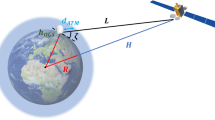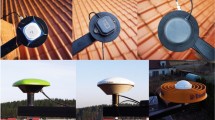Abstract
We report on the progress in the realization of an electronic / optical simulator for space based, long arm interferometry and its application to the eLISA mission. The goal of this work is to generate realistic optics and electronics signals, especially simulating realistic propagation delays. The first measurements to characterize the simulator are also presented. With the present configuration, noise reduction factors of 5×107 for optical beat notes and 109 for RF beat notes have been achieved using the Time Delay Interferometry algorithm. The principle of the experiment has been validated and further work is ongoing to identify the residual noise sources and optimize the apparatus.













Similar content being viewed by others
References
Bykov, I., Delgado, J.J.E., Marin, A.F.G., Heinzel, G., Danzmann, K.: Lisa phasemeter development: Advanced prototyping. J. Phys. Conf. Ser. 154(1), 012,017 (2009) http://stacks.iop.org/1742-6596/154/i=1/a=012017
Danzman, K., et al.: eLISA L2 White paper : The Gravitational Universe. https://www.elisascience.org/articles/elisa-mission/elisa-l2-white-paper (2013). [Online; accessed 28-August-2013]
Danzman, K., et al.: Elisa science web site. https://www.elisascience.org (2013). [Online; accessed 28-August-2013]
Danzmann, K.: {LISA} mission overview. Adv. Space Res. 25(6), 1129–1136 (2000). doi:10.1016/S0273-1177(99)00973-4. Fundamental Physics in Space http://www.sciencedirect.com/science/article/pii/S0273117799009734
Dhurandhar, S., Ni, W.T., Wang, G.: Numerical simulation of time delay interferometry for a lisa-like mission with the simplification of having only one interferometer. Adv. Space Res. 51(1), 198–206 (2013). doi:10.1016/j.asr.2012.09.017 http://www.sciencedirect.com/science/article/pii/S0273117712005893
Dhurandhar, S.V.: Time-delay interferometry and the relativistic treatment of lisa optical links. J. Phys. Conf. Ser. 154(1), 012,047 (2009) http://stacks.iop.org/1742-6596/154/i=1/a=012047
Esteban, J.J., García, A.F., Barke, S., Peinado, A.M., Cervantes, F.G., Bykov, I., Heinzel, G., Danzmann, K.: Experimental demonstration of weak-light laser ranging and data communication for lisa. Opt. Express 19(17), 15,937–15,946 (2011). doi:10.1364/OE.19.015937. http://www.opticsexpress.org/abstract.cfm?URI=oe-19-17-15937
Esteban, J.J.J., Bykov, I., Marín, A., Heinzel, G., Danzmann, K.: Optical ranging and data transfer development for lisa. J. Phys. Conf. Ser. 154(1), 012,025 (2009) http://stacks.iop.org/1742-6596/154/i=1/a=012025
Fleddermann, R., Steier, F., Tröbs, M., Bogenstahl, J., Killow, C., Heinzel, G., Danzmann, K.: Measurement of the non-reciprocal phase noise of a polarization maintaining single-mode optical fiber. J. Phys. Conf. Ser. 154(1), 012,022 (2009) http://stacks.iop.org/1742-6596/154/i=1/a=012022
Heinzel, G., Esteban, J.J.J., Barke, S., Otto, M., Wang, Y., Garcia, A.F., Danzmann, K.: Auxiliary functions of the lisa laser link: ranging, clock noise transfer and data communication. Class. Quantum Gravity 28, 4008 (2011) http://adsabs.harvard.edu/cgi-bin/nph-data_query?bibcode=2011CQGra..28i4008H&link_type=ABSTRACT
Jennrich, O., et al.: LISA assessment study report (Yellow Book). http://sci.esa.int/lisa/48364-lisa-assessment-study-report-yellow-book/ (2011). [Online; accessed 28-August-2013]
Jennrich, O., et al.: NGO assessment study report (Yellow Book). http://sci.esa.int/ngo/49839-ngo-assessment-study-report-yellow-book/ (2012). [Online; accessed 28-August-2013]
José Esteban, J., García, A.F., Eichholz, J., Peinado, A.M., Bykov, I., Heinzel, G., Danzmann, K.: Ranging and phase measurement for LISA. J. Phys. Conf. Ser. 228(1), 012045 (2010). doi:10.1088/1742-6596/228/1/012045
McKenzie, K., Spero, R.E., Shaddock, D.A.: Performance of arm locking in lisa. Phys. Rev. D 80, 102,003 (2009). doi:10.1103/PhysRevD.80.102003
Mitryk, S., Wand, V., Mueller, G.: Verification of time-delay interferometry techniques using the university of florida lisa interferometry simulator. Class. Quantum Gravity 27, 084,012 (2010) http://www.google.com/search?client=safari&rls=en-us&q=Verification+of+time-delay+interferometry+techniques+using+the+University+of+Florida+LISA+interferometry+simulator&ie=UTF-8&oe=UTF-8
Mitryk, S.J., Mueller, G., Sanjuan, J.: Hardware-based demonstration of time-delay interferometry and tdi-ranging with spacecraft motion effects. Phys. Rev. D 86, 122,006 (2012). doi:10.1103/PhysRevD.86.122006
Otto, M., Heinzel, G., Danzmann, K.: Tdi and clock noise removal for the split interferometry configuration of lisa. Classical and Quantum Gravity 29(20), 205,003 (2012) http://stacks.iop.org/0264-9381/29/i=20/a=205003
Petiteau, A.: De la simulation de lisa a l’analyse des donnees. Ph.D. thesis, Université Paris Diderot - Paris 7 (2008)
Petiteau, A., Auger, G., Halloin, H., Jeannin, O., Plagnol, E., Pireaux, S., Regimbau, T., Vinet, J.Y.: Lisacode: A scientific simulator of lisa. Phys. Rev. D 77, 23,002 (2008). doi:10.1103/PhysRevD.77.023002. http://adsabs.harvard.edu/cgi-bin/nph-data_query?bibcode=2008PhRvD..77b3002P&link_type=ABSTRACT
Shaddock, D.A., Tinto, M., Estabrook, F.B., Armstrong, J.W.: Data combinations accounting for lisa spacecraft motion. Phys. Rev. D 68, 061,303 (2003). doi:10.1103/PhysRevD.68.061303
Shaddock, D.A., Ware, B., Spero, R.E., Vallisneri, M.: Postprocessed time-delay interferometry for lisa. Phys. Rev. D 70, 081,101 (2004). doi:10.1103/PhysRevD.70.081101
Sheard, B.S., Gray, M.B., McClelland, D.E., Shaddock, D.A.: Laser frequency stabilization by locking to a {LISA} arm. Phys. Lett. A 320(1), 9–21 (2003). doi:10.1016/j.physleta.2003.10.076. http://www.sciencedirect. com/science/article/pii/S0375960103016578
Sutton, A., McKenzie, K., Ware, B., Shaddock, D.A.: Laser ranging and communications for lisa. Opt. Express 18(20), 20,759–20,773 (2010). doi:10.1364/OE.18.020759. http://www.opticsexpress.org/abstract.cfm?URI=oe-18-20-20759
Sutton, A., Shaddock, D.A.: Laser frequency stabilization by dual arm locking for lisa. Phys. Rev. D 78(082), 001 (2008). doi:10.1103/PhysRevD.78.082001
Sutton, A.J., McKenzie, K., Ware, B, de Vine, G., Spero, R.E., Klipstein, W., Shaddock, D.A.: Improved optical ranging for space based gravitational wave detection. Class. Quantum Gravity 30(7), 075,008 (2013) http://stacks.iop.org/0264-9381/30/i=7/a=075008
Sweeney, D., Mueller, G.: Experimental verification of clock noise transfer and components for space based gravitational wave detectors. Opt. Express 20(23), 25,603–25,612 (2012). doi:10.1364/OE.20.025603. http://www.opticsexpress.org/abstract.cfm?URI=oe-20-23-25603
Sylvestre, J.: Simulations of laser locking to a lisa arm. Phys. Rev. D 70, 102,002 (2004). doi:10.1103/PhysRevD.70.102002
Thorpe, J., Maghami, P., Livas, J.: Time domain simulations of arm locking in lisa. Phys. Rev. D 83(12), 122,002 (2011). doi:10.1103/PhysRevD.83.122002. http://prd.aps.org/abstract/PRD/v83/i12/e122002
Thorpe, J.I.: Lisa long-arm interferometry. Class. Quantum Gravity 27(8), 084,008 (2010) http://stacks.iop.org/0264-9381/27/i=8/a=084008
Tinto, M., Dhurandhar, S.V.: Time-delay interferometry. Living Rev. Relativ. 8(4) (2005). doi:10.12942/lrr-2005-4. http://www.livingreviews.org/ lrr-2005-4
Tinto, M., Shaddock, D.A., Sylvestre, J., Armstrong, J.W.: Implementation of time-delay interferometry for lisa. Phys. Rev. D 67, 122,003 (2003). doi:10.1103/PhysRevD.67.122003
Tröbs, M., Heinzel, G.: Improved spectrum estimation from digitized time series on a logarithmic frequency axis. Measurement 39(2), 120–129 (2006). doi:10.1016/j.measurement.2005.10.010
Tröbs, M., Heinzel, G.: Corrigendum to ‘improved spectrum estimation from digitized time series on a logarithmic frequency axis’ [measurement 39 (2006) 120 - 129]. Measurement 42(1), 170 (2009). doi:10.1016/j.measurement.2008.04.004. http://www.sciencedirect.com/science/article/pii/S0263224108000705
Vallisneri, M.: Geometric time delay interferometry. Phys. Rev. D 72(4), 042,003 (2005) http://scholar.google.com.rproxy.sc.univ-paris-diderot.fr/scholar?hl=en&lr=&q=info:dAzoZjt071MJ:scholar.google.com/&output=search
Vallisneri, M. Phys. Rev. D 76(10), 109,903 (2007) http://scholar.google.com.rproxy.sc.univ-paris-diderot.fr/scholar?hl=en&lr=&q=info:JkBcMQqodxQJ:scholar.google.com/&output=search
de Vine, G., Ware, B., McKenzie, K., Spero, R.E., Klipstein, W.M., Shaddock, D.A.: Experimental demonstration of time-delay interferometry for the laser interferometer space antenna. Phys. Rev. Lett. 104, 211,103 (2010). doi:10.1103/PhysRevLett.104.211103
Wand, V., Yu, Y., Mitryk, S., Sweeney, D., Preston, A., Tanner, D., Mueller, G., Thorpe, J.I., Livas, J.: Implementation of armlocking with a delay of 1 second in the presence of doppler shifts. Journal of Physics: Conference Series 154(1), 012,024 (2009) http://stacks.iop.org/1742-6596/154/i=1/a=012024
Acknowledgments
This work has been funded by the French Space Agency (CNES), under grants R-S07/SU-0001-012 and R-S08/SU-0001-012.
Author information
Authors and Affiliations
Corresponding author
Appendices
Appendix A: development of time delay interferometry equations
The combination of the recorded signals results in the following equations:
Also, the back-link fiber being reciprocal [9], which means that the added noise from 1 to 1’ is identical to the noise added when propagating from 1’ to 1: \(\eta _{B;1} = \eta _{B;1^{\prime }}\),the differential noise between laser 1 and 1’ can be deduced from s R e f;1 and \(s_{Ref;1^{\prime }}\):
Practically, the laser frequencies will not be let freely running but will be phase locked on a master, frequency stabilized source (e.g. Laser 1). From the previous equations, assuming perfect correction, this phase locking means that:
Assuming that δ O B;q =0 and η B;q =0 (these noises can be subtracted using s T O;q and s R e f;q signals) and neglecting both test mass and other local noises (δ T M =o x x;q =0), this configuration is effectively equivalent to a transponder, where the phase noises of the incoming beams on S/C 2 and 3 are transferred on the beams sent back to S/C 1.
Appendix B: phasemeter reference measurement
The ASD of data recorded on channel 1 and the ASD of the difference between channel 1 and 2 are represented on Fig. 14.
The ASD of raw values and differences between other channels give very similar results. These results show that the raw data are slightly above the eLISA requirements for the phase measurement noise, while the differential measurement between two channels is marginally compatible with the requirement. The difference between the two curves are due to a relatively strong common mode between the channels, whose origin is unclear for the moment, but could be due, e.g. to a residual phase jitter between the reference signal (at 72.001 MHz in this experiment) and the synthesized 2.001 MHz signal.
Rights and permissions
About this article
Cite this article
Grüning, P., Halloin, H., Prat, P. et al. Status of the eLISA on table (LOT) electro-optical simulator for space based, long arms interferometers. Exp Astron 39, 281–302 (2015). https://doi.org/10.1007/s10686-015-9448-z
Received:
Accepted:
Published:
Issue Date:
DOI: https://doi.org/10.1007/s10686-015-9448-z





